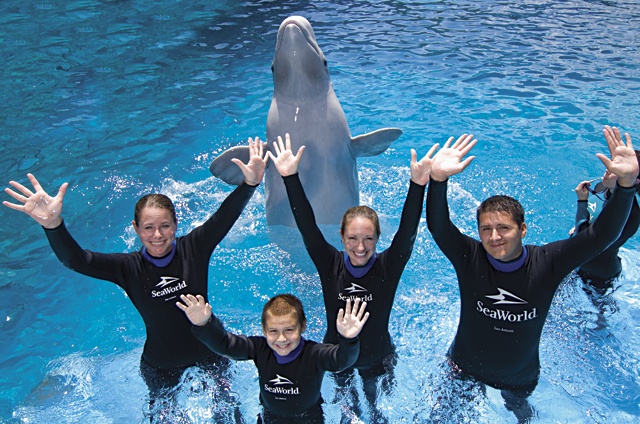Natasha, a 1,300-pound beluga whale, glides to where I stand in thigh-high water on the edge of an 18-foot-deep training pool at SeaWorld San Antonio. From 3 feet away, she raises her massive white head and sprays chilly saltwater over my wetsuit-encased body. Sputtering, I give the hand signal for Natasha to dive and circle back to me. Her quick response means she understands. I’m talking to a whale!
In the Beluga Interaction Program, Natasha’s reward is a fistful of restaurant-quality herring when she does as requested. I interpret her high-pitched whistles and squeaks as pride in her achievement—and her desire for fish, of course.
A few minutes’ acquaintance with a chatty beluga whale validates the species’ nickname, “canary of the seas.” Belugas, which hear at higher frequencies than humans, make at least 11 different vocalizations by emitting sounds through their blowholes. In the pool, we communicate with visual cues, using a sign language that the whales learn through “successive approximation training.” That training breaks down a whale’s behavior (nodding its head, floating on its back, racing around the pool) into baby steps, says Shirlee Crandall, technical senior trainer for the program.
“We make it enjoyable for them so they want to do it, so they are choosing to participate. Just like kids, they learn the small, easy behaviors first,” Crandall says. Every time a whale responds correctly to a command, the behavior is reinforced, usually with a batch of whole fish. Training and social interaction are voluntary on the whales’ part. If they don’t want to do what is requested, or don’t understand a command, at the end of the day they still get their full ration of fish, which runs between 20 and 75 pounds, depending on body weight.
For effective training, Crandall explains, it’s important to learn the preferences of each whale. In addition to fish, whales learn to enjoy other forms of praise, such as belly rubs, splashes and whale toys, such as balls. The 12-year-old Luna, for example, really likes to play with toys. Natasha, meanwhile, rarely does.
An estimated 80,000 to 100,000 belugas swim in the Arctic and subarctic waters off Alaska, Greenland and Canada, although their numbers are threatened by several factors, including water pollutants and commercial hunting. Charcoal gray at birth, belugas turn whiter with age (thereby blending with ice as a camouflage against predators) and can grow to 16 feet long and about 3,000 pounds on a main diet of fish, squid and crabs.
SeaWorld’s eight belugas swim in 2.5 million gallons of chilly 58-degree saltwater. The whales range in age from Natasha and Martha, in their 30s—belugas can live 50 years—to 2-year-old baby Atla, one of nine belugas born in San Antonio over the past two decades. Every day, year-round, each beluga participates in four to eight learning, play and exercise sessions under the guidance of nine trainers. The interaction program, which continues even when SeaWorld is closed, mixes participants like me into the whales’ learning and play sessions.
“You are trainers in the water today. You are going to be asking for behaviors and then reinforcing behaviors,” trainer Kelly Adamonis tells the 10 of us who have signed up for an afternoon session. Martin Brophy, a serious 11-year-old from Goliad, chose the whale interaction program as his birthday present. A couple from Del Rio are taking the figurative plunge with whales to celebrate their engagement. Annie Reese, 17, envisions a future in marine biology. We squeeze into SeaWorld wetsuits and split into three groups.
After we ease onto the pool’s submerged ledge, wading in shallow water where we will stay, trainer Laura Meitin describes the signal I will give Luna. With clasped hands, I give Luna the sign to wiggle her melon, the dome on her massive head. She does so and drops open her huge mouth for a fish snack. Luna’s flexible pectoral (side) flippers—soft and cool to my fingers—keep her balanced, while her tail propels her through the water at speeds up to 14 mph.
Meitin runs Luna through her repertoire so each participant standing in the water gets to communicate with, touch and reward the enthusiastic whale. I twirl like a ballerina, and so does Luna. I discover that Luna knows her left from her right better than I do. She gets a belly rub and splashes for her cooperation.
Meitin slaps the water, calling Imaq, a 1,900-pound whale, to us. Meitin nods at him, and he nods back. She hands us fish, and we hold them beneath the surface, where Imaq slurps them out of our hands. Meitin circles her thumb and forefinger: “This is his cue to make a series of different noises.” But Imaq keeps making the same noise. Meitin tells us to stand still for three seconds and not acknowledge this incorrect behavior, saying, “I’m not communicating in a way he understands. Maybe I’m giving the hand signal incorrectly.”
But Imaq interprets the next signals perfectly. He springs out of the water like a dolphin, curving up and splashing down, and we give him his reward. A headstand, his tail waving high, follows as does a marlin-like backward tail walk.
Imaq gives me my first whale kiss—a cold, gentle buss on my cheek. I kiss him back, planting a heartfelt smooch on his giant domed head.
Being in the water with belugas is educational, but the true joy comes from building a relationship with a whale. With squeaks, whistles and playful splashes, Luna, Imaq and Natasha talk to me in the only “sign language” I understand. That these beautiful giants allow me to touch them and are willing to touch me back speaks volumes.
——————–
Eileen Mattei, frequent contributor


